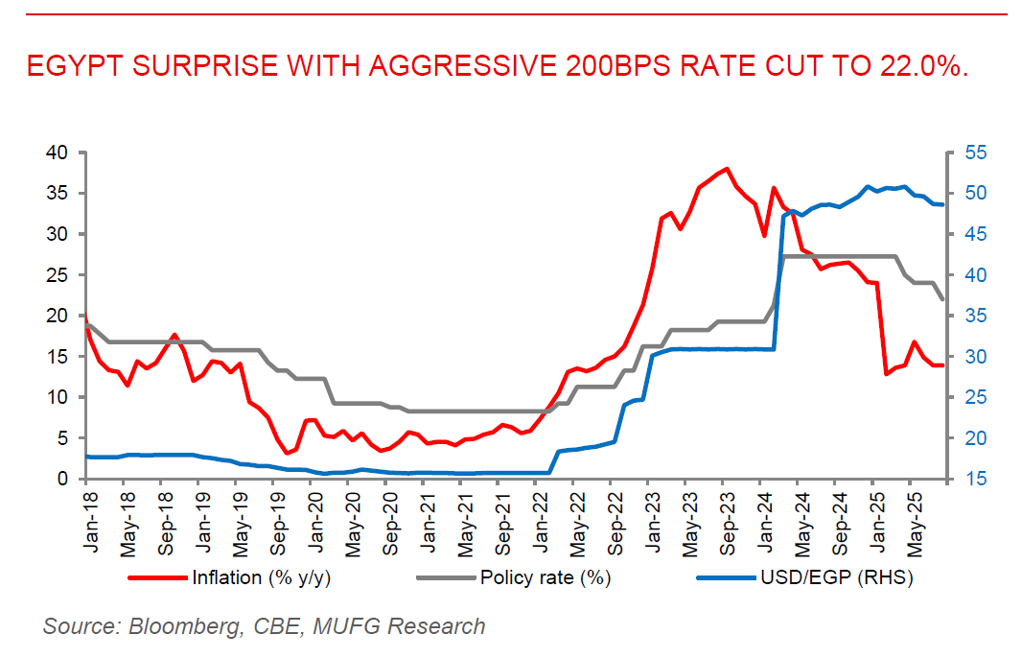To read the full report, please download the PDF above.
Middle East Daily
SOOJIN KIM
Research Analyst
DIFC Branch – Dubai
T: +44(4)387 5031
E: soojin.kim@ae.mufg.jp
MUFG Bank, Ltd. and MUFG Securities plc
A member of MUFG, a global financial group
Middle East Daily
COMMODITIES / ENERGY
Oil set for first monthly loss since April amid surplus concerns. Oil prices edged lower, with Brent slipping below USD68/b and WTI near USD64/b, setting both benchmarks on course for their first monthly loss since April as traders weighed the risk of a looming supply glut. Brent has already dropped around 5% in August, reflecting expectations that global supply will outpace demand in the coming quarters, especially as OPEC+ restores capacity and producers outside the alliance ramp up output, while the IEA has warned of a record surplus ahead. The weakness also reflects broader concerns about demand after escalations in the US-led trade war, alongside uncertainty over US’s efforts to push India away from Russian crude through a 50% tariff hike on imports. Overall August’s decline highlights how the combination of supply expansion, trade policy risks, and fragile demand growth has weighed on crude, leaving the market vulnerable to further losses.
Gold nears record as Fed policy uncertainty and inflation risks boost demand. Gold steadies around USD3,415/oz today, heading for a second straight weekly gain that has brought it closet to April’s record high of about USD3,500/oz, as investors awaited a crucial US inflation reading expected to influence the Fed’s rate path. Stronger than expected US growth data raised concerns about renewed price pressures, with today’s personal consumption expenditure print projected to accelerate, potentially limiting the Fed’s ability to cut rates, a scenario that usually weighs on non-yielding gold. Still dovish remarks from Fed Governor Christopher Waller, who said he supports a 25bps cut in September with further reductions over the next three to six months, buoyed expectations of a September cut.
MIDDLE EAST - CREDIT TRADING
End of day comment – 28 August 2025. Another mixed day. Market goes out with a better feel than in the morning though. Buying from account side slightly outnumbered selling as well, especially ETFs flipped to buying from yesterday’s selling. After the relentless steepening of the UST curve today saw some consolidation and some flattening which brought some buying out in long end bonds but dealers seem happy to let bonds go. Spreads on balance are going out unchanged. In IG QATAR was busy again, in the long end there is a preference for low cash price 46s and 50s (+0.265pt/-1bp) vs 48s. There was also some activity in short end 28s and 29s without moving prices/spreads though. ADGB again in comparison quieter, 49s was active closing +0.5pt/unch. Quasis saw buying in QPETRO 31s (+0.375pt/-3bp). Corps has still sellers in ALDAR seniors, closing 34s and 35s -0.125pt/+5bp there. DPWDU also a touch wider in spreads but higher in cash, 37s had some activity (+0.125pt/+2bp). Fins were quiet but overall feels like the chase for bonds has stopped at these yield levels. On the new issue side new Saudi bank deals did much better than the BSFR LT2 yesterday. New Alinma perps closed around 100.20 from 100 reoffer. New SABBAB LT2 was more active and closed last around 100.375 from 100 reoffer. BSFR LTS recovered somewhat closing last around 99.625.
MIDDLE EAST - MACRO / MARKETS
Egypt surprise with aggressive 200bps rate cut to 22.00%. Central Bank of Egypt (CBE) cut interest rates for the first time since May, reducing both the benchmark deposit rate and lending rate by 200bps to 22% and 23% respectively, as it seeks to revive investment and ease one of the region’s highest debt-serving burdens. The Monetary Policy Committee (MPC) justified the decision by pointing to a broad-based easing in price dynamics over the past two months and more favourable exchange rate developments, which it said created sufficient room for a “measured resumption of monetary easing.” Inflation is now projected by the CBE to average between 14% and 15% in 2025, providing space for further gradual cuts. Forward guidance emphasised a meeting-by-meeting approach, with the MPC committed to reassessing the scale and pace of future easing in line with incoming data and risk balance. Even after the latest move, the real policy rate stands at around 8ppts, which is considered sufficiently high to anchor disinflation and maintain support for the Egyptian pound, barring major global or geopolitical shocks.
Saudi Arabia’s net foreign assets dip in July despite strong annual growth. Official figures published by the Saudi Central Bank yesterday revealed that Saudi Arabia’s net foreign assets fell sharply, by around SAR50bn (USD13.3bn) bringing the total to SAR1.58 trillion (USD420.3bn) from SAR1.63 trillion in June, highlighting a notable monthly decrease. Nonetheless, reserves remain robust, showing a 5.6% y/y increase compared to July 2024. Policymakers view the monthly decline as a temporary liquidity adjustment rather than a structural drain, given the continued strength of Saudi Arabia’s external reserves to buttress economic stability in the prevailing global uncertainty.

